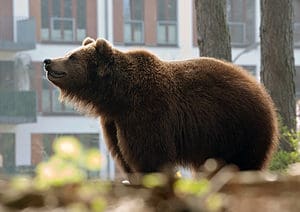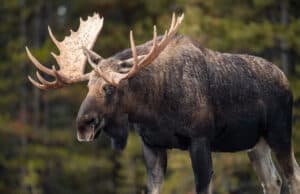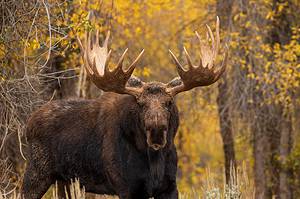Moose are majestic creatures that roam the forests and wilderness of North America, known for their massive size and impressive antlers. When envisioning a moose, most people picture a male with its towering antlers, but have you ever wondered if female moose can also possess this iconic feature?
In this article, we will explore the fascinating world of moose antlers, delving into the question of whether female moose can have antlers and uncovering the various ways these magnificent creatures utilize their antlers.
Join us as we unravel the mysteries of moose biology and delve into the intriguing behaviors surrounding their antlers. Prepare to be captivated by the wonders of these remarkable animals and gain a deeper understanding of their unique characteristics.
Can Female Moose Have Antlers?

The moose mating season is between September and October.
©RT Images/Shutterstock.com
Under normal circumstances, female moose, known as cows, do not have antlers. Antler growth and shedding are primarily driven by hormonal changes in males. However, in rare situations, a female moose may grow antlers. This can occur due to factors such as hormonal imbalances, tumors, or other abnormalities. It is important to note that this is considered unusual and not the norm for female moose.
It is worth mentioning that the growth and shedding of antlers in moose are primarily associated with the reproductive behavior and dominance of male moose. The antlers play a significant role in attracting mates and establishing dominance during the mating season. Female moose, on the other hand, do not require antlers for these purposes.
If a female moose were to grow antlers, it would be an exception rather than the rule. The vast majority of female moose do not possess antlers.
5 Ways Moose Use Their Antlers

During mating season, male moose, known as bulls, use their antlers to compete for females.
©Keiki/Shutterstock.com
Moose use their antlers for various purposes, primarily related to reproduction, dominance, and defense. Here are some of the ways moose use their antlers:
1. Mating Competition:
During the autumn mating season, male moose, known as bulls, employ their formidable antlers in intense competition for access to females. Engaging in fierce battles known as “rutting,” these bulls clash their antlers together, displaying their strength and determination to establish dominance and secure mating rights. These battles are often dramatic and highly physical, with the bulls charging at each other, and their antlers colliding with tremendous force. Only the most dominant and powerful bulls emerge victorious from these clashes, earning the privilege of mating with receptive females. This competitive display of strength and aggression highlights the significance of antlers as a key factor in the reproductive success of bull moose during the mating season.
2. Attracting Mates:
The size and condition of a bull moose’s antlers play a significant role in attracting female moose, known as cows. These discerning females may choose their mates based on the size and symmetry of the antlers, as they are often regarded as indicators of a healthy and genetically superior bull. Larger and more symmetrical antlers suggest robustness and optimal genetic traits, which can enhance the chances of healthy offspring.
The selection process by female moose underscores the importance of antlers in signaling fitness and ensuring the propagation of desirable genetic characteristics. Thus, bull moose with impressive antlers enjoy a competitive advantage in securing mates and passing on their superior genetic traits to future generations.
3. Dominance Displays:
Bull moose employ their impressive antlers as a means to assert dominance and discourage competition from other males. They engage in sparring or fights by forcefully clashing their antlers together, and it is often the larger and more formidable bull that emerges victorious. This intense display of strength and aggression serves as a clear message to rivals, establishing hierarchy and determining mating rights.
The clashes of moose antlers are a visual spectacle, showcasing the moose’s power and demonstrating their genetic superiority. Through these battles, bull moose establish their dominance and ensure the preservation of their genes, further highlighting the crucial role that antlers play in the intricate social dynamics and reproductive success of these majestic creatures.
4. Defense:
Moose, particularly bulls, possess antlers that serve as formidable weapons for defense against predators like bears and wolves. When faced with a threat, a moose instinctively lowers its head and points its impressive antlers as a warning to deter potential attackers. The sheer size and strength of the antlers, combined with the moose’s imposing stature, create a formidable deterrent.
The visual display of moose antlers is often enough to dissuade predators from pursuing an attack, as they understand the potential danger they would face. This defensive behavior showcases the adaptability and resourcefulness of the moose, utilizing its antlers not only for mating rituals and communication but also as a powerful means of self-defense in the face of danger.
5. Communication:
Antlers not only serve as impressive physical attributes, but they also play a crucial role as a communication tool among moose. When a moose senses danger or seeks to establish dominance, it adopts a powerful stance by lowering its head and pointing its antlers forward, sending a clear warning to other moose or potential threats. This behavior is a visual signal that communicates a message of strength and readiness to defend its territory or resources.
The sheer size and grandeur of moose antlers, combined with this assertive posture, effectively convey the moose’s intent and serve as a deterrent to rivals or predators. Through this remarkable display, moose demonstrate the intricate and multifaceted nature of their communication methods, further highlighting the significance of their magnificent antlers.
In Conclusion
In conclusion, the world of moose antlers is a captivating realm filled with wonder and intrigue. While it is true that female moose do not typically grow antlers, they play a crucial role in the mating rituals and survival strategies of male moose. From the fierce battles for dominance to the alluring displays that attract potential mates, the antlers of male moose are a testament to their strength and genetic superiority. Furthermore, these impressive appendages serve as a means of communication and defense, allowing moose to navigate their environment and protect themselves from predators.
From the battles for dominance to the courtship rituals that ensure the survival of the species, the antlers of moose are truly a testament to the marvels of the natural world. So, the next time you catch a glimpse of a majestic moose, take a moment to marvel at the magnificence of its antlers. Reflect on the remarkable ways in which they shape the lives of these incredible creatures.
The photo featured at the top of this post is © Green Mountain Exposure/Shutterstock.com
Thank you for reading! Have some feedback for us? Contact the AZ Animals editorial team.







